How should we seize the opportunities brought by the “black swan”?
In the past two months, the epidemic situation has profoundly changed the trajectory of people’s daily life, and it has also shaped and cultivated many new consumption habits. But are these changes short-lived or have they brought an indelible mark to the consumer industry? How should we grasp the opportunities brought by the “black swan”? There are many opinions, only numbers can tell everything.
In the past three weeks, the Consumer Internet Industry Group of Huaxing Investment Bank, through research with 1,000 consumers, strived to present to you the most objective way to present the psychological changes, consumer expectations, and retail, health Fresh e-commerce, online education and beauty and skin care trends in the four sub-segments. This is a real and interesting report, and we have selected the core points to share with you.
Consumers: The impact of the epidemic will not reduce consumer confidence, and will benefit offline consumption with strong social attributes in the short term
1. Consumer confidence runs high before the outbreak
The differentiation of consumer sentiment in high- and low-tier cities returns to the fundamentals of consumers before the outbreak. According to a report released by Nielsen, the Chinese consumer trend index, which represents consumer confidence, maintained a high level in the third quarter of 2019, significantly leading the world, reflecting Consumers in China have good employment expectations, willingness to consume, and personal economic conditions.

Among them, high-end and low-end cities show different trends. Since the third quarter of 2018, the consumer trend index of second- and third-tier cities has surpassed first-tier cities and has become a new engine of consumer confidence growth. The reason behind this is that the cost of living in high-tier cities is high, consumer income growth has slowed down, and consumption has become more rational and cautious; while the supply of public resources in middle- and low-tier cities has increased, the number of middle-class consumers has increased, and their willingness to buy has increased.
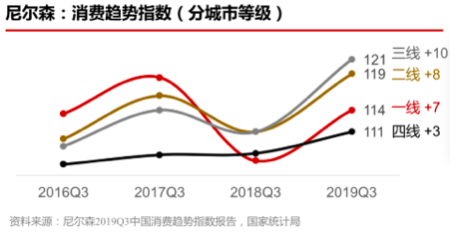
2. Consumer income is generally damaged during the epidemic, and the short-term consumption basis is still guaranteed
Among the 1,000 samples we surveyed, 949 samples still had income during the epidemic, but they were generally negatively affected, and about 70% of the income decreased compared with the same period last year., Including a significant reduction in 20% of revenue.
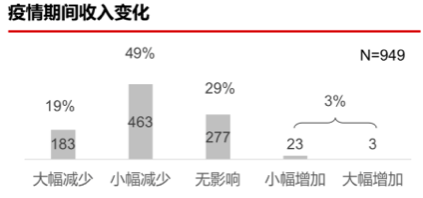
The decrease in income is related to wage structure and occupation. Except for retirees and civil servants, which are mostly reflected as no impact due to the rigidity of wages, the most common reduction in other occupations is a small decrease; a significant decrease in income is more common without fixed wages Occupations, such as freelancers, self-employed businesses, and a portion of the service industry; increased income is scattered across occupations, caused by individual factors.

During the epidemic, 50% of the sample consumption decreased, mainly due to reduced demand or suppressed demand at home. After the epidemic passed, the consumption of this type of population was likely to recover; in contrast, the case of active consumption reduction was Accounted for relatively little. In the sample of increased consumption, only 42% of people had passive consumption caused entirely by epidemic prevention, and the expenditures just needed during the epidemic may become their burden, while the other 58% of people ’s increased consumption contained more or less controllable Active consumption.
Changes in consumer loans can represent consumer financial stress. During the epidemic, 19% of the sample consumer loans increased, but by analyzing the changes in their income and consumption expenditure, it can be found that the increase in consumer loans is more closely related to the increase in consumption during the epidemic, while the consumption loans of people with only a decrease in income rarely increase, indicating that income Although the reduction has spread widely, consumers’ daily expenses have not been affected, and the short-term consumption basis is still guaranteed.
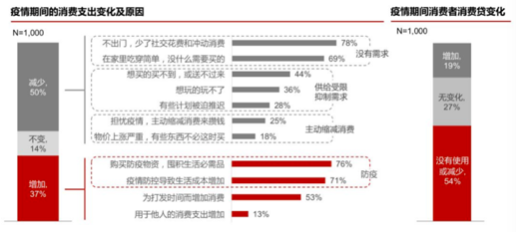
3. Consumers have a rational and objective expectation of annual income, without panic.

Similar to the distribution of changes in actual income during the epidemic, about 70% of the samples are expected to reduce their annual income. On the basis of prediction, about 80% of the samples are based on the changes in income during the epidemic period, and only 10% think that their income situation will further deteriorate after the epidemic is over, thus making the whole year’s expectations even more pessimistic.
4. Expectations of retaliatory consumption are widespread, and offline consumption with strong social attributes is expected to benefit significantly in the short term
About 55% of the samples are expected to exhibit retaliatory consumer behavior in the short term after the epidemic has ended. This expectation is widespread in all populations, with little difference shown by age and gender.

Factors affecting retaliatory consumption. The first is economic strength. High-income people are expected to have stronger retaliatory consumption. The second is the extent of the impact of the epidemic, losing freedom in the epidemic, encountering difficulties in life, infringement of rights or rights People with psychological stress are more likely to experience retaliatory consumer behavior.
This shows that “revenge consumption” is actually a type of “compensatory consumption”, while “compensatory consumption” is irrational and non-functional psychological consumption, which is determined by emotions rather than consumption views. People who have been hit harder in the epidemic have more negative emotions or psychological imbalances. They only want to repair them through consumption. They do not consider changes in their own income and therefore “lose within their means.” Reflect a higher propensity to retaliate.
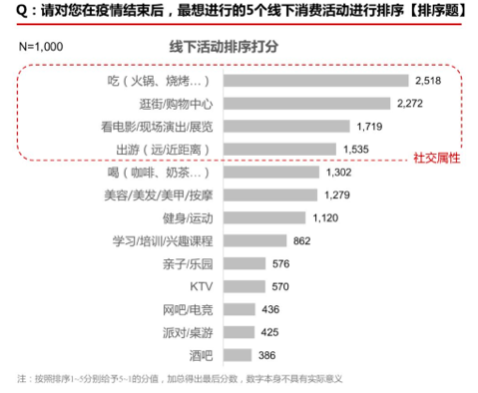
It is not difficult to find from the ranking results of the most popular offline consumption activities that mass consumption with strong social attributes is expected to rebound first.

Most people will resume simple offline consumption within a week to a month after the end of the epidemic, that is, assuming that the domestic epidemic is basically over at the end of April, possible retaliatory consumption will occur in mid-late May.
5. Consumption grading trend does not decrease, and the willingness to save in middle and high-tier cities is increasing

The social resonance that occurred during the epidemic made more than half of consumers more rational and more proactive, and in this respect only the fourth-tier cities were less affected.
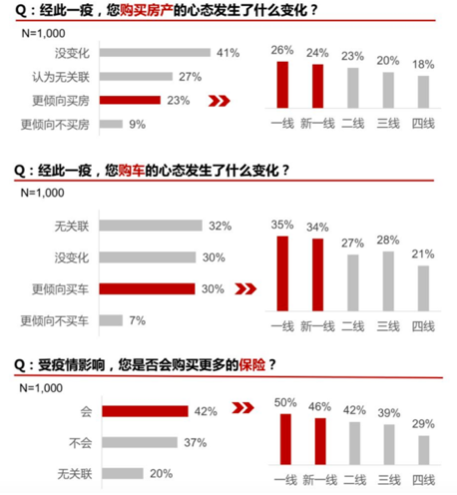
At the same time, the epidemic has also caused some consumers to start thinking about the need to buy a house, car, and insurance. Although these purchase plans are also affected by personal economic strength, qualification restrictions and policies, the effect of boosting related industries remains to be seen. But it will prompt some consumers to increase their savings rate. In terms of city level, high-tier cities and lower-tier cities have stronger willingness to buy houses, cars, and insurance, which makes consumers in high-tier cities more inclined to save money and intensifies the trend of consumer grading.
6. Consumption expectations of newcomers and new middle-class workers have declined, and students and middle-aged and elderly groups have better consumer confidence.

The overall negative impact of the epidemic on consumption is expected to continue for some time, although this does not prevent a wave of retaliatory rebound in the short term after the epidemic has ended.
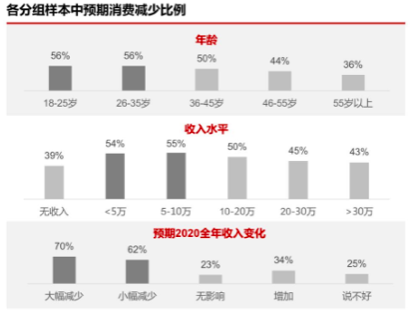
51% of the sample is expected to reduce consumption within one year after the end of the epidemic. Among them, young people aged 18-35 and low-income people have a higher proportion of reducing consumption. This part of the population is mostly new workers in the workplace and new middle class; The above middle-aged and elderly groups and non-income student groups still maintain good consumer confidence. In 2020, people who have reduced their income, especially those who have greatly reduced, are more inclined to reduce their long-term consumption. Even if these people are affected by emotions, they will have retaliatory consumer behavior in the short term, but they will return to rationality afterwards. What matters is real income levels and consumer confidence.
Among the reasons for reducing consumption, more than half of the people chose to change their consumption views, and the reasons for increasing consumption were mostly passive increases caused by the epidemic.
Segmented industries: “Online substitution” consumption accelerates penetration, and “Yueji” consumption remains strong.
1. Retail categories: epidemic prevention and “house” economic categories benefit, and there is still momentum of inertial growth after the epidemic
![Will retaliatory consumption come after the epidemic? Here are a thousand consumers who told the truth.]()
During the epidemic, among the retail categories, health protection, freshness, medicine and health care, leisure snacks, and exercise and fitness increased the proportion of people in the population. In addition to health protection and medical care directly related to epidemic prevention, the increase in consumption of fresh food, leisure snacks and sports and fitness is caused by “homes.”
The “Spring Festival” consumer goods such as gifts, clothing accessories, alcohol, as well as 3C digital and household appliances are more seriously damaged, and the proportion of people who reduce consumption is more than 50%. Among similar categories, the unit price is low, and the type of home demand is less affected. For example, beverages are better than alcohol, small appliances are better than home appliances, and beauty and skin care are better than clothing accessories.
During the epidemic, the online trend of fresh and casual snacks is the most obvious, especially the fresh online channels, which have obtained the double benefits of increased total volume and increased penetration from the consumer.

After the epidemic, health protection, freshness, and medical and health care products are expected to have inertial growth momentum; clothing accessories and beauty skin care benefit from potential retaliatory consumption expectations, and are expected to welcome the main “compensating consumption” category To rebound sharply.
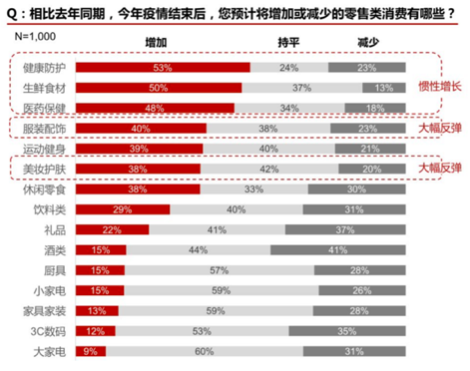
2. Fresh food e-commerce: Consumer education in high-tier cities has basically been completed, 80% of consumers have become sticky after the epidemic, focus on regional leaders and sink channel opportunities
Of the 1,000 samples, 732 had purchased fresh food from online channels during the epidemic period, and the penetration rate was skewed towards high-level cities, annual income levels above 100,000 yuan, and young adults aged 26-45. Among them, the penetration rate of first-tier cities has reached 85%, indicating that consumer education in high-tier cities has been basically completed.
![Will retaliatory consumption come after the epidemic? Here are a thousand consumers who told the truth.]()
![Will retaliatory consumption come after the epidemic? Here are a thousand consumers who told the truth.]()
Of the people who increased their purchases (or at least stayed the same) during the epidemic, 89% of them will purchase more after the epidemic than before the epidemic, and online purchases forced by consumers during the epidemic will more or less form habits .
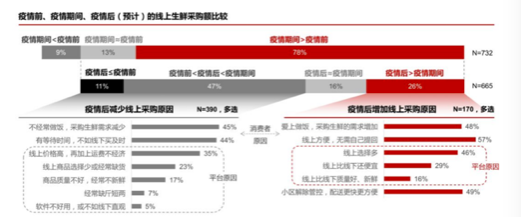
Regardless of the increase or decrease in purchases after the epidemic, the impact of differences in individual consumer preferences is relatively large, such as whether to cook for themselves, save time and effort, and then blame the platform experience. Among the driving factors related to the platform, the large selection space and low price are the main driving factors for consumers to stay online.
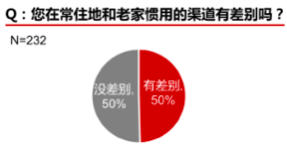
By asking about samples in the place of habitual residence and hometown during the epidemic, we can find that half of the people use different fresh channels in different regions, which indicates that the strong platforms in different regions are different.
Due to the high overall penetration rate of fresh food e-commerce in high-tier cities, the penetration rate of most channels in high-tier cities is higher than that in low-tier cities, but at the same time, high-line penetration has almost peaked and competition is fierce. There is still much room for development in the tier cities. Some channels or models focus on sinking opportunities. For example, some chain supermarkets in the self-employed are obviously working in third- and fourth-tier cities. In addition, the formats of community groups and local community fresh food stores are also more acceptable in low-tier cities.
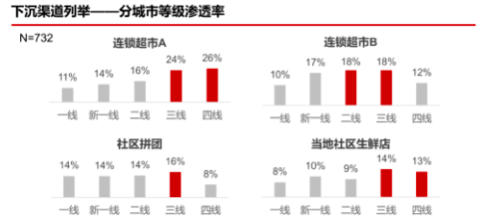
3. Online education: During the epidemic, a lot of low-cost traffic was obtained. The expected repurchase rate of head players is relatively optimistic, and operation and product competitiveness become the key to follow-up
Of the 611 samples with underage children, 448 had used online subject courses during the epidemic, and the penetration rate of the entire sample was 73%; the penetration rate at the junior high and middle school levels was significantly higher than that of kindergartens and elementary schools.

During the epidemic, due to the suspension window and alignmentThe replacement demand for tutoring classes, more than half of the parents increased online education consumption.
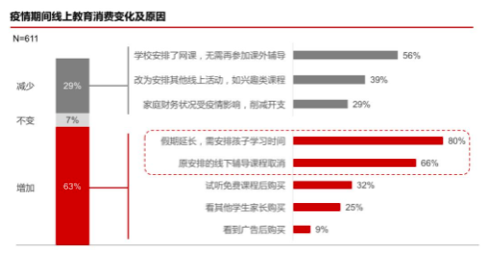
The epidemic has brought a lot of low-cost traffic to online education. Taking the head subject tutoring platform A as an example, nearly half of the paying people who used the platform during the epidemic were newly paid during the epidemic.
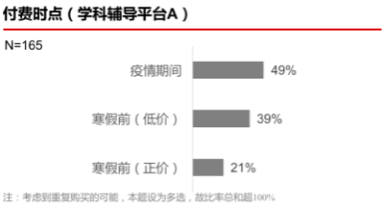
Looking at the payment and repurchase rates of various head platforms, the proportion of paying people is basically in the range of 45-60%, and the overall repurchase rate is about 60%. Retention expectations are good.

The reasons why consumers choose not to repurchase are partly due to temporary needs and partly because online education is considered ineffective. In the future, the main battlefield of online education will shift from traffic competition to operation and product competitiveness.
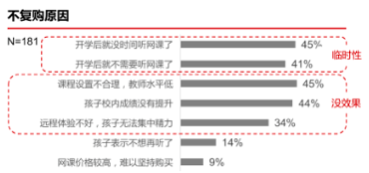
4. Beauty and skin care: The epidemic has only suppressed short-term demand, the industry’s strong growth trend has not changed, and there are obvious signs of rebound
During the epidemic, the reduction and increase of skincare products are similar, while the proportion of beauty products reducing consumption is significantly higher. One of the reasons is the difference in demand.

The decrease in consumption is mainly caused by the decline in demand and supply in a short period of time. It can naturally recover after the epidemic. The proportion of people who choose to save money and store more goods is the lowest. It can be seen that the impact of the epidemic on wallets has not hurt women. Passion for the optional consumption of beauty and skin care products; correspondingly, the increase in consumption has nothing to do with demand, indicating that demand has rarely increased during the epidemic and is mainly affected by (online) marketing methods.
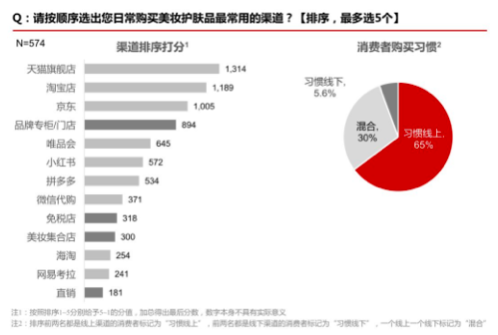
Tmall, Taobao, and JD.com are the three most commonly used channels for female consumers to buy beauty and skin care products, followed by offline brand counters. On the whole, the official formal channels are highly accepted. The degree of online beauty and skincare products is very high. Only 6% of women still prefer offline channels to shop, and the advantages of online channels will be particularly prominent during the rebound.
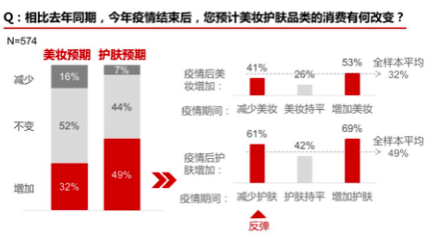
The proportion of beauty and skincare products expected to increase consumption after the epidemic is significantly higher than that during the epidemic period, in which skin care is still better than beauty, increasing the number of consumers by nearly half; those who reduce consumption during the epidemic are more inclined to increase consumption after the epidemic. Signs of a rebound are clear.
During the epidemic, among the retail categories, health protection, freshness, medicine and health care, leisure snacks, and exercise and fitness increased the proportion of people in the population. In addition to health protection and medical care directly related to epidemic prevention, the increase in consumption of fresh food, leisure snacks and sports and fitness is caused by “homes.”
The “Spring Festival” consumer goods such as gifts, clothing accessories, alcohol, as well as 3C digital and household appliances are more seriously damaged, and the proportion of people who reduce consumption is more than 50%. Among similar categories, the unit price is low, and the type of home demand is less affected. For example, beverages are better than alcohol, small appliances are better than home appliances, and beauty and skin care are better than clothing accessories.
During the epidemic, the online trend of fresh and casual snacks is the most obvious, especially the fresh online channels, which have obtained the double benefits of increased total volume and increased penetration from the consumer.

After the epidemic, health protection, freshness, and medical and health care products are expected to have inertial growth momentum; clothing accessories and beauty skin care benefit from potential retaliatory consumption expectations, and are expected to welcome the main “compensating consumption” category To rebound sharply.

2. Fresh food e-commerce: Consumer education in high-tier cities has basically been completed, 80% of consumers have become sticky after the epidemic, focus on regional leaders and sink channel opportunities
Of the 1,000 samples, 732 had purchased fresh food from online channels during the epidemic period, and the penetration rate was skewed towards high-level cities, annual income levels above 100,000 yuan, and young adults aged 26-45. Among them, the penetration rate of first-tier cities has reached 85%, indicating that consumer education in high-tier cities has been basically completed.
Of the people who increased their purchases (or at least stayed the same) during the epidemic, 89% of them will purchase more after the epidemic than before the epidemic, and online purchases forced by consumers during the epidemic will more or less form habits .

Regardless of the increase or decrease in purchases after the epidemic, the impact of differences in individual consumer preferences is relatively large, such as whether to cook for themselves, save time and effort, and then blame the platform experience. Among the driving factors related to the platform, the large selection space and low price are the main driving factors for consumers to stay online.

By asking about samples in the place of habitual residence and hometown during the epidemic, we can find that half of the people use different fresh channels in different regions, which indicates that the strong platforms in different regions are different.
Due to the high overall penetration rate of fresh food e-commerce in high-tier cities, the penetration rate of most channels in high-tier cities is higher than that in low-tier cities, but at the same time, high-line penetration has almost peaked and competition is fierce. There is still much room for development in the tier cities. Some channels or models focus on sinking opportunities. For example, some chain supermarkets in the self-employed are obviously working in third- and fourth-tier cities. In addition, the formats of community groups and local community fresh food stores are also more acceptable in low-tier cities.

3. Online education: During the epidemic, a lot of low-cost traffic was obtained. The expected repurchase rate of head players is relatively optimistic, and operation and product competitiveness become the key to follow-up
Of the 611 samples with underage children, 448 had used online subject courses during the epidemic, and the penetration rate of the entire sample was 73%; the penetration rate at the junior high and middle school levels was significantly higher than that of kindergartens and elementary schools.

During the epidemic, due to the suspension window and alignmentThe replacement demand for tutoring classes, more than half of the parents increased online education consumption.

The epidemic has brought a lot of low-cost traffic to online education. Taking the head subject tutoring platform A as an example, nearly half of the paying people who used the platform during the epidemic were newly paid during the epidemic.

Looking at the payment and repurchase rates of various head platforms, the proportion of paying people is basically in the range of 45-60%, and the overall repurchase rate is about 60%. Retention expectations are good.

The reasons why consumers choose not to repurchase are partly due to temporary needs and partly because online education is considered ineffective. In the future, the main battlefield of online education will shift from traffic competition to operation and product competitiveness.

4. Beauty and skin care: The epidemic has only suppressed short-term demand, the industry’s strong growth trend has not changed, and there are obvious signs of rebound
During the epidemic, the reduction and increase of skincare products are similar, while the proportion of beauty products reducing consumption is significantly higher. One of the reasons is the difference in demand.

The decrease in consumption is mainly caused by the decline in demand and supply in a short period of time. It can naturally recover after the epidemic. The proportion of people who choose to save money and store more goods is the lowest. It can be seen that the impact of the epidemic on wallets has not hurt women. Passion for the optional consumption of beauty and skin care products; correspondingly, the increase in consumption has nothing to do with demand, indicating that demand has rarely increased during the epidemic and is mainly affected by (online) marketing methods.

Tmall, Taobao, and JD.com are the three most commonly used channels for female consumers to buy beauty and skin care products, followed by offline brand counters. On the whole, the official formal channels are highly accepted. The degree of online beauty and skincare products is very high. Only 6% of women still prefer offline channels to shop, and the advantages of online channels will be particularly prominent during the rebound.

The proportion of beauty and skincare products expected to increase consumption after the epidemic is significantly higher than that during the epidemic period, in which skin care is still better than beauty, increasing the number of consumers by nearly half; those who reduce consumption during the epidemic are more inclined to increase consumption after the epidemic. Signs of a rebound are clear.